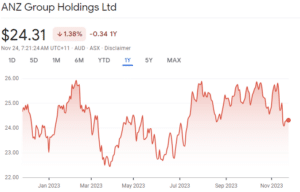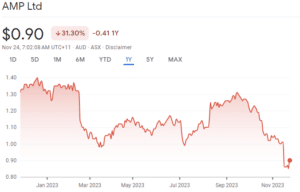ANZ Vs AMP: Who Should Make it into Your Portfolio in 2024?
![]() Ujjwal Maheshwari, November 28, 2023
Ujjwal Maheshwari, November 28, 2023
2023 becomes a crucial year for ANZ (Australia and New Zealand Banking Group) as well as AMP Limited, both facing unique economic troubles and pursuing different tactics. The Australian and New Zealand Banking Group Ltd (ANZ) records a static statutory profit of $7.1 billion and a 14% increment in cash profit, whereas, on the other hand, AMP Limited retains its NPAT at $112 million. The complexity behind any company’s ability to survive in the world market is different and we have attempted to unfold what exactly makes the difference between ANZ and AMP.
ANZ is driving up dividends
Despite facing a tough market in 2023, both ANZ and AMP limited had distinct financial performances during the same period. ANZ’s financial stability manifested itself through a regular statutory profit amounting to $7.1 bn and a strong growth of its cash profit to $7.4 bn – it is an indicator of the fact that its business strategy is effective and working. The company also recorded a 20% hike in dividends per share which shows that management is devoted to rewarding investors. On the other hand, AMP held its NPAT at an average level of $112 million despite the turbulent environment in the markets. In addition, the company made an effort to maintain its shareholder-focused stance by repaying close to $610 million to its stockholders – including a $70 million interim dividend as well as a clever buying back program. AMP also reduced its corporate debt by $302 million demonstrating a sound management decision-making process. These performances collectively portray two strong financial companies that are effectively using their resources and business approach toward stability and growth amidst an uncertain economy.
ANZ Group Holdings Ltd (ANZ)
ANZ’s operational strategy in 2023 was characterised by strong performance across its four core divisions: Australia Retail, Australia Commercial, New Zealand, and institutional. The bank increased in all its areas of business, especially its Home lending growth and substantial returns in the Australia Commercial division. In this regard, ANZ restructured its operations focusing on profitable, diversified business segments, leading to new record cash flow and revenues. The commitment of the bank towards sustainability was visible through the fact that it planned to finance or channel $100 billion by the year 2030 for environmental as well as societal causes.

AMP (AMP) driving down costs
AMP Limited aimed at improving their cost efficiencies. It aimed for at least $120 million in cost savings by FY25, which would require a substantial investment of about $120 to $150 million. This move shows that AMP is focusing on long-term operational efficiency and profits. Following the issues with the economy, such as the 4% rise in the cash rate and increased prices for household items, AMP focused on prudential loan book management and cost control. In facing stiff competition in the banking industry with increasing funding costs, AMP decided to increase its relationship with brokers and offer attractive bank deposits.

How to survive turbulent financial markets
ANZ and AMP adopted different strategies to grow strong in an unstable economic climate in 2023. Rather than diversifying away from underperforming aspects, ANZ increased capital outlays on digital transformation and sustainability. The company created an identity for itself as a banker that values transparency and technology while simultaneously differentiating itself from other banks in Australia. However, the market situation in which AMP Limited encountered increased competition and volatility was more difficult. To deal with these difficulties, AMP focused on improving broker relationships and offering better depositing channels, which could be seen as an indication of movement toward customer-oriented strategies and digitization.
Challenges of their own
Amid shared economic problems, a closer look at the future shows that ANZ and AMP travel divergent roads. ANZ has an ambitious program aimed at expanding the digital bank–ANZ plus, improving productivity levels, and fulfilling the promise of sustainability. Its strategy involves buying Suncorp Bank as part of strengthening its position in Australia’s Retail and Commercial sectors. Nevertheless, ANZ has to cope with high fluctuations in interest rates and prices.
Conversely, AMP’s future is based on expansion into major business lines and efficiency enhancement of the operations, combined with the elimination of legacy problems. However, AMP has its problems, such as unresolved litigation, significant expenditure needed to achieve economies of scale and exposure to the volatile market that threatens its ability to produce more at lower prices and hence generate profits.
What are the Best ASX Stocks to invest in right now?
Check our buy/sell tips on the top Stocks in ASX
We prefer ANZ over AMP
The two are evenly matched in financial stability, with ANZ demonstrating continuous profits and improved dividends versus AMP, which has maintained its profitability but is cautious. However, ANZ has a greater strategic advantage over AMP due to its diversified approach and focus on digital innovation in comparison with AMP’s strategy which relies upon cost-effectiveness and flexibility within the current environment.
It implies that ANZ adopts complete procedures of digitization as well as sustainability whereas AMP tends to operate internally by being efficient in their operations as well as capital management. As a result, the ANZ has a wider market reach and strategic acquisition that gives room for extensive growth while AMP is tasked with overcoming market challenges and litigations.
Blog Categories
Get Our Top 5 ASX Stocks for FY25
Recent Posts
Apple’s iPhone Production in Focus: Is the Tariff Pause Enough to Ease the Pressure?
Apple, one of the largest and most influential tech companies in the world, is no stranger to the fluctuations of…
Why travel shares are getting slammed…and it is not for the reasons you may think
Just when ASX travel shares were out of the COVID-19 doldrums (in that some surpassed their pre-COVID highs), 2025 looks…
Capital Gains Tax on Stocks: Here’s what you need to know
Investors may be liable to pay Capital Gains Tax on Stocks, but may not know the nuances of how it…




